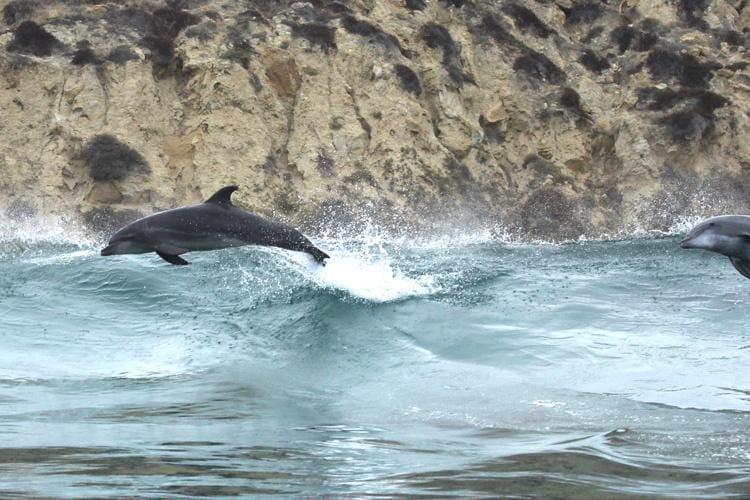
The Gulf of Mexico has a diverse marine wildlife population. The most popular water animal in our area is probably our dolphins. There are nine species of Gulf coast dolphins. Near shore we frequently see Common Bottlenose, Fraser’s, Pantropical Spotted, and Spinner dolphins. Further offshore we see Clymene, Risso’s, Rough-Toothed, Striped, and Atlantic Spotted dolphins.
Local Dolphin Species
- Common Bottlenose – This is the most common species found in our waters. Common bottlenose dolphins get their name from their short, thick snout. They are usually gray in color and feed on a variety of prey, such as fish, squid, crabs and shrimp. Interestingly, they use innovative techniques to pursue and capture prey such as herding and trapping schools of fish against sand bars and seawalls.
- Fraser’s – These dolphins have a stocky body with a small, distinct snout with a dark stripe from their eye to their flipper that resembles a racoon mask. Their upper body is a bluish or brownish-gray and their underside is usually pale. They are strong and splashy swimmers that can dive up to 2,000 feet to feed on deep-sea fish, crustaceans, and cephalopods.
- Pantropical Spotted – This species is relatively small, growing to six or seven feet and about 250 pounds. They have long, slender white tipped snouts and a dark cape over their backs from their heads to the fork of their tales. They have been known to live up to 46 years with sexual maturity occurring around 11 years of age.
- Spinner – These are considered one of the most acrobatic of dolphins. They are famous for leaping out of the water and spinning up to seven times in the air before reentry. Spinners are slender with thin flippers and dorsal fins that stand straight or curve slightly. Their color varies greatly depending on the subspecies and location. They usually have a dark gray dorsal/top cape, a light gray side, and a white belly. Frequently they prefer areas with a sandy bottom and good visibility so they can watch for predators as they do not use echolocation while resting.
Good Neighbors
Just like everyone else, dolphins love a free lunch. Frequently, they will visit fishing boats in Pensacola Bay and the Intercoastal waterway to steal bait or fish. This provides a great opportunity for a close encounter with these graceful animals. Unfortunately, feeding them makes them more likely to approach boats putting them in danger of injury. Dolphins are protected under the Marine Mammal Protection Act. It is illegal to intentionally feed or interact with them. Litter in the water also poses a threat to all marine wildlife. Though dolphins rarely eat plastic, they do consume fish that have eaten plastic. Please enjoy these beautiful animals, but at a distance. And, as always, be sure your trash ends up in an appropriate receptacle.
Further Reading
Check out the websites below to learn more about our dolphins. Special thanks to all of them for assisting with my research!
Panama City News Herald’s guide to 9 dolphins found in the Gulf of Mexico: https://www.newsherald.com/photogallery/DA/20191218/NEWS/423009993/PH/1
National Oceanic and Atmospheric Administration’s (NOAA’s) article on Fraser’s dolphins: https://www.fisheries.noaa.gov/species/frasers-dolphin
NOAA’s article on Common Bottlenose dolphins:
https://www.fisheries.noaa.gov/species/common-bottlenose-dolphin
NOAA’s article on Spinner dolphins:
https://www.fisheries.noaa.gov/species/spinner-dolphin
NOAA’s article on Pantropical Spotted dolphins:
https://www.fisheries.noaa.gov/species/pantropical-spotted-dolphin
Check out our Things to See page for other attractions in the Pensacola area!
https://www.pensacolapontoons.com/wp-admin/post.php?post=65&action=edit


Recent Comments